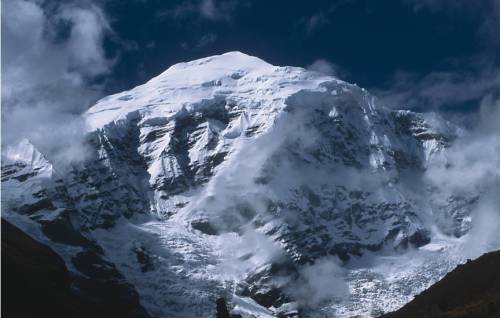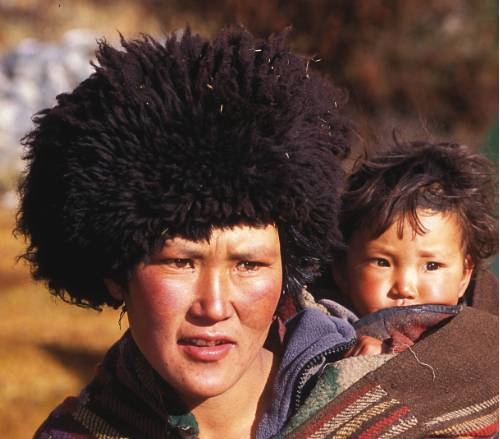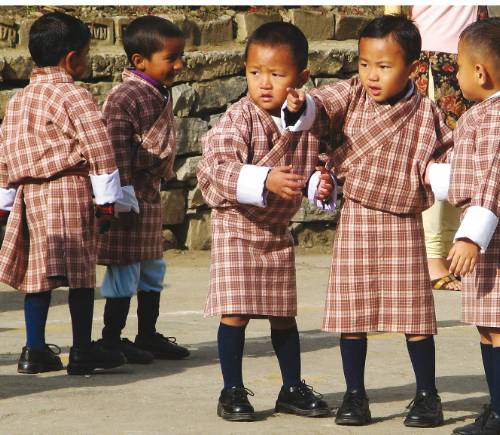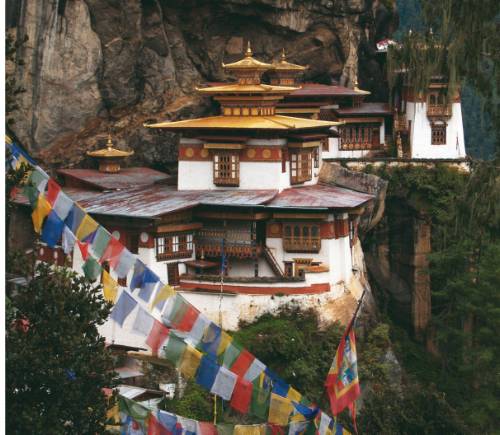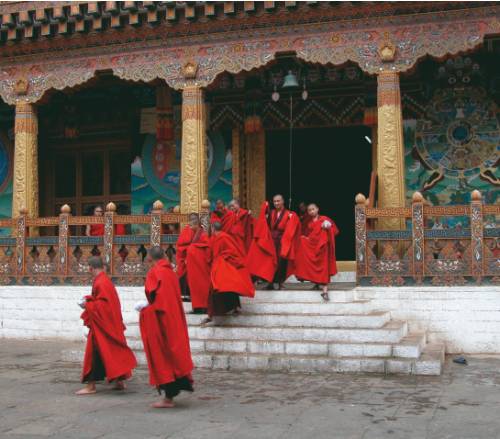Jomolhari Base Camp Trek
Jomolhari Base Camp Trek
$6420
Tour Overview
Embark on the Jomolhari Base Camp Trek, a captivating journey through the heart of Bhutan's stunning landscapes and rich cultural heritage. This trek offers an unparalleled experience, crossing the high passes of Nyile La and Yale Pass, and camping beneath the sacred peak of Jomolhari. As you traverse the breathtaking Himalayan terrain, you'll be immersed in the vibrant culture of Bhutan, exploring ancient dzongs and mountain monasteries. The trek is fully supported, ensuring a comfortable and enriching adventure. Enjoy the classic views of the Himalayas, with expert guidance and all necessary equipment provided. Indulge in the local cuisine with 11 breakfasts, lunches, and dinners included, and rest in quality accommodations in Paro. This trek is a perfect blend of natural beauty and cultural exploration, promising an unforgettable experience in the Kingdom of Bhutan. ...more ...less
Highlights
Itinerary
Day 1 : Join Paro (2200m).
Location: Paro
Accommodation Name: Hotel
After clearing customs and immigration you will meet your Bhutanese leader and drive a short distance via the main street of Paro to our accommodation. At some stage of our visit, we have planned visits to the main part of town, and a visit to the National Museum. It will depend on our time of arrival into Paro, and when trek preparations are completed. The touring program will take in the grand Paro Dzong which dominates the valley and is the most important Dzong (fortress) in Bhutan. It is the model by which all other dzongs are constructed. The watchtower above it, Ta Dzong, is also an impressive building that houses the National Museum that is very informative. Old costumes and battle dress, together with priceless jewellery and specimens of the kingdom's unique flora and fauna are included within the museum. Downtown, there is a mixed collection of shops selling basic goods, and also handicrafts of wood, cloth and metalware. Archery is the national sport and practised throughout Bhutan. Shooting ranges lined by willow trees can be seen during our travels, as well as some traditional style bridges.
Overnight: Hotel ...more ...less
Day 2 : Paro Valley, Takstang Monastery (3100m) & National Museum
Location: Paro Valley
Accommodation Name: Hotel
A really exciting and informative day as an introduction to this wonderful country (described in part above). The Paro valley is truly beautiful, being a location for various farming activities, including commercial quantities of asparagus, strawberries and shitake mushrooms for export, plus various grain and vegetable crops. It is a patchwork of colours delineated by well kept traditional design farm houses that are ornately decorated. All of the slopes surrounding the valley are forested and the hint of mountains beyond is alluring. Our morning is spent exploring and appreciating the Tigers Nest Monastery or Taktsang, as it is known in Bhutan, a short drive from our resort. It takes us about 1.5 hours to walk up the winding trail steeply through chir pine forest to a tea house and excellent vantage point. Another 30 minutes or so takes us to the monastery. The monastery is the divine resting place of the Guru Rinpoche, revered as the founder of Tibetan Buddhism. This evening you will need to repack, leaving behind things you will not require on the trek for safe storage with our local partner.
Overnight: Hotel
Day 3 : Drive past Drukyel Dzong (2580m) to Shana (2860m) and commence trek to Thongo Zampa (3250m), (11kms, approx 4 hrs)
Location: Paro Valley
Accommodation Name: Camp
It is a short drive of approx 20 minutes up the Paro valley to Drukyel Dzong, which was originally built as a fortress in 1647 to guard against Tibetans invading the Paro Valley. We continue the drive to Shana (1-1.5h drive) from where our trek commences. On this scenic drive we pass through farm country made up of fields of rice, wheat, barley, mustard, potato, and radish as well as herds of cows. The traditional Bhutanese two storey, timber and stone houses can be seen here. We also gain our first views of the summit of Jomolhari (7314m) at the head of the valley. We get under way and take a break for lunch where it suits us, as we are carrying a packed lunch. Initially the trail is wide and flat, as it meanders steadily through lightly forested fields, which in recent years have been the site of the ongoing large-scale Bhutan Government project to bring electricity to the isolated villages further up the valley. Overnight camp Thongo Zampa.
Day 4 : Trek to Soi Thangthangkha (3700m) (approx 4 hrs)
Location: Jigme Dorji National Park
Accommodation Name: Camp
We now trekking within Jigme Dorje National Park, the largest protected area in the country (4350 sq kms.) which extends beyond Laya to Lunana in the east and all the territory to the south. Whilst it is a protected wilderness, the park management which is based at Gasa, has to cope with the needs of lowland farmers and semi-nomadic yak herders. There is an amazing variety of species of plants and animals in the park at both high and low altitudes. The forests are tall and thick, comprising a variety of oaks, maple, birch, larch pine and allders that will be replaced by more and more rhododendron and pines as we trek higher. There are numerous different varieties of the former, and depending on the onset of warmer temperatures after winter, flowers will be in bloom, or past bloom, as the lower altitudes flower earliest. As we climb higher the rhododendron species change from the common rhododendron arboreum (Nepal's national flower) to griffithianum and cinnabarinum.
Many of the camps we stop at are not settlements as might be implied by them having a place name. Most are merely clearings beside a water source, which are also suitable camping sites for seasonal yak herders and workers who are involved in the large scale electrification project that will bring electricity to this region of Bhutan.
Day 5 : Trek to Jomolhari base camp, "Jangothang" 4100m (12kms, approx 5 hours)
Location: Jomolhari
Accommodation Name: Camp
We continue higher to the camp at the base of Jomolhari, a superb alpine setting. Jichu Drake (6794m) rises to our right, with a fine, elegant ridge running down toward the pass that we will cross on our next trekking day. We camp in the vicinity of yak herders from the Paro Valley, who, like their counterparts in Southern Tibet, live in woven yak wool tents throughout the summer months. By now we are above the treeline and the area is characterised by low tundra of juniper and rhododendron setosum, while blue sheep have also been spotted in the higher rocky outcrops.
Day 6 : At Jomolhari base camp, "Jangothang", rest & explore
Location: Jomolhari
Accommodation Name: Camp
An important day is set aside for acclimatisation. A side trip up the small valley towards Jomolhari takes us to a dramatic viewpoint towards the glacier and imposing face of this 7000m mountain. Alternatively we may make a scenic excursion up to Sopu lake set adjacent to Nye La pass, both will be worthy photo excursions. As far as mountaineering is concerned, these two peaks, like the rest of Bhutan, have seen little expedition activity from outsiders. Doug Scott successfully climbed Jichu Drake in 1988 on his third attempt, demonstrating that conditions are not so easy on this far east location of the Himalaya being first in line geographically for monsoonal influences.
Day 7 : Cross Nyile La (4850m) (18kms, approx 8 hrs)
Location: Lingshi
Accommodation Name: Camp
From camp we commence our ascent over rolling slopes of grassland and small brush to the Nyile La (4850 metres). This is a relatively long day on the trail, so if this is your first Himalayan pass just take your time, particularly on the final steeper stages just below the pass, where grasses give way to scree and sand. The views enroute to Jichu Drake will inspire you. From the Nyile La we leave Jomolhari and Jichu Drake behind and make a steep descent through dwarf rhododendron shrub towards Lingshi village. In the distance we can soon see the Lingshi Dzong, built to protect this and the other outlying villages of Bhutan from the periodic raids from Tibet. Before we reach the village and the Dzong, we turn off descending to cross a stream, there is a short stiff climb and then a descent into the quiet valley and camp by a stream.
Day 8 : Cross Yale La (4950m) and trek to Shodu (3950m) (Walk approx 8 hrs)
Location: Yale La
Accommodation Name: Camp
Today is the most difficult day so an early start is essential. We begin our walk and ascend gradually through the valley until the stiff climb to Yale La pass at 4950 metres the highest point of the trip. The final push to the top of the pass is hard work, but certainly worthwhile! The panoramic view of Jomolhari (7314m), Jichu Drake (6794m) and Tshrim Gang is breathtaking. After the pass it is a long descent to our camp at Shodu (3950m).
Day 9 : To Barshong (3700m), (Walk approx 7/8hrs)
Location: Barshong
Accommodation Name: Camp
The path follows the Thimchu River descending through rhododendron, Juniper and pine forests. The view of the cliff facing rocks and water falls are stunning. The trail gradually ascends after 3 to 4 hours to the ruins of Barshong Dzong and our camp for the night.
Day 10 : Complete trek at Dolam Kencho (Walk approx. 5/6hrs). Transfer to Thimphu (approx. 2hrs)
Location: Thimphu
Accommodation Name: Hotel
The path descends for a while joining the Thimchu river and gradually ascending and descending through thick bamboo and pine forests. We walk for around 2 hours to reach our old campsite at Domshesha before continuing for another 3-4 hours to Dolam Kencho and the roadhead. Transfer to Thimphu. Pending arrival time, we may visit the Tashichho Dzong, on the time of arrival, we may visit Thimphu Dzong in the afternoon. Any baggage left in Paro on day 2 will be transferred and be available at the hotel in Thimphu. Overnight: Hotel.
Day 11 : In Thimphu, transfer to Paro (approx. 2hrs.)
Location: Thimphu
Accommodation Name: Hotel
This morning there is ample time to get a feel for the country's capital or do some shopping in the bazaar. The main Secretariat building, the Tashichho Dzong is the most prominent building consisting of the main Secretariat, the National Assembly Hall, the Office of the King and the Throne Room. Its remarkable construction is in traditional Bhutanese style completed without the use of nails or metal of any kind. There is a large Stupa dedicated to the late King HM. Jigme Dorji Wangchuk, regarded as the founder of modern day Bhutan. Then there is the Handicraft Emporium with famous weaving, woodcarvings and paintings and also the Post Office - Bhutan's exquisite stamps are world-renowned.
Overnight: Hotel
Day 12 : Trip concludes in Paro.
Location: Paro
Meals Included: Breakfast
Trip concludes after breakfast with a transfer to the airport.
What's Included
-
Accommodation
4 nights hotel -
Airport transfers
Airport transfers are included on Day 1 and Day 12.
-
Expert bilingual guide
An expert bilingual guide is included in the tour.
-
Safety equipment
Safety equipment including a portable altitude chamber, group medical, and satellite phone is provided.
-
World Expeditions trek pack
The use of a World Expeditions trek pack, which includes a quality sleeping bag, down or fibre fill jacket, and insulated mat, is included.
-
Group camping equipment
All group camping equipment is included.
-
Private transportation
Private transportation is included throughout the tour.
-
Park entrance fees and trekking permits
All park entrance fees and trekking permits are included.
-
Animal support
Animals are provided to carry 20kgs of personal equipment.
-
Sightseeing and site entry fees
Sightseeing and site entry fees as listed are included.
-
Souvenir kit bag
A souvenir World Expeditions kit bag is included.
What's Not Included
-
International flights
International flights are not included in the tour package.
-
Bottled water
Bottled water is not included.
-
Aerated and alcoholic drinks
Aerated and alcoholic drinks are not included.
-
Personal items
Items of a personal nature such as phone calls and laundry are not included.
-
Tips
Tips are not included in the tour package.
-
Airport and departure taxes
Airport and departure taxes are not included.
-
Travel insurance
Travel insurance is not included and is recommended to be arranged separately.
What You Carry
In your daypack you will need to carry warm clothing (depending on the altitude, location and weather), two water bottles, camera, and personal items such as sunscreen, etc. Porters and mules carry all group gear and your duffle bag.
Grading
On a moderate trek physical activity will generally not exceed eight hours in a day, and altitudes generally not exceeding 5,500 metres. On a moderate adventure the physical activity is sustained and travelers should be comfortable with occasional rough terrain. At any stage of a moderate trek you can expect long steep climbs and descents and a wide range of weather conditions. An example of an average day on moderate trek could include several ascents and descents of 500 metres or more, level ground is rare in the mountains.
To prepare for a moderate trek you should begin training at least four to five months before your departure. As a guideline, an hour of aerobic exercise three to four times per week would be considered a minimum requirement. The best preparation is bushwalking involving relatively steep ascents and descents.If you can manage a couple of valley floor to ridgeline ascents per bushwalk, albeit with stops along the way, you will cope with a moderately graded trek. Speed is not important, stamina, confidence and continuity are.
...more ...less
Mode of Transport
Private transportation is provided, including airport transfers and transfers between trek locations, ensuring a comfortable journey throughout the tour.
Accommodation
Enjoy good quality accommodation in Paro, with hotel stays at the beginning and end of the trek, and camping in scenic locations during the trek, including the base of Jomolhari.
Check out our Q&As
-
What kind of physical preparation is recommended for the Jomolhari Base Camp Trek?
To prepare for the Jomolhari Base Camp Trek, which is graded as moderate, you should begin training at least four to five months before your departure. An hour of aerobic exercise three to four times per week is considered a minimum requirement. The best preparation is bushwalking involving relatively steep ascents and descents. If you can manage a couple of valley floor to ridgeline ascents per bushwalk, albeit with stops along the way, you will cope with a moderately graded trek. Speed is not important, but stamina, confidence, and continuity are. ...more ...less
-
What should I carry in my daypack during the trek?
During the trek, you should carry warm clothing depending on the altitude, location, and weather, two water bottles, a camera, and personal items such as sunscreen in your daypack. Porters and mules will carry all group gear and your duffle bag.
-
What is the highest point reached during the Jomolhari Base Camp Trek?
The highest point reached during the Jomolhari Base Camp Trek is the Yale La pass at 4950 meters.
-
What kind of accommodation is provided during the trek?
During the trek, you will camp at various sites, some of which are clearings beside a water source suitable for seasonal yak herders and workers. In Paro and Thimphu, good quality hotel accommodation is provided.
-
What kind of views can I expect during the trek?
During the trek, you can expect classic views of the Himalayas, including the sacred peak of Jomolhari, Jichu Drake, and Tshrim Gang. The trek also offers panoramic views from high passes and scenic vistas of valleys, forests, and traditional Bhutanese landscapes.
-
What cultural experiences are included in the Jomolhari Base Camp Trek?
The trek includes cultural experiences such as exploring ancient dzongs and mountain monasteries, including the grand Paro Dzong and the Tigers Nest Monastery. You will also have the opportunity to experience the rich culture of Bhutan in towns like Paro and Thimphu.
-
Who will be my travelling companions on the tour?
We have offices on three continents which means your travelling companions will be just that – international and wonderfully eclectic. Part of small group travel means that although travellers come from various locations and backgrounds, you will be travelling with like-minded companions who, like you, are keen to share the experience and forge lifelong friendships.
-
What about environmental impact?
We believe that adventure travel revolves around establishing a strong relationship with the people and environments in which we operate. Our responsible travel policies have been carefully developed to ensure that we minimise the impact of our presence and help to protect the regions we visit while contributing positively to the local community.
-
What should I pack?
Your pre-departure documents include a detailed packing list with items that you need to bring. While most of the equipment for daily activities is included in your tour cost, some items like helmets and hiking boots are best brought from home. The pre-departure documents also include information on layering and recommended brands for various items to ensure you are fully prepared for your trip.
-
Do you operate a “single share” option and how does it work?
Yes. World Expeditions does not require single travellers to pay a surcharge for travelling alone on the vast majority of our trips. Our holidays are primarily on a twin share basis, so if you are joining the group as a solo traveller, we will match you with someone of your own gender. The choice is yours however; if you prefer not to share, we do offer single supplements for private occupancy.
-
Are tips included in my trip price?
Tips are not included in the tour cost. Tipping is a personal thing, do not worry about how much, or when, to tip. Tipping guidelines are provided for certain destinations in our pre departure information upon booking, however the best advice will be provided by your tour leader.
-
Am I suited to small-group travel?
We recognise that many of our travellers have not been on a ‘group trip’ before. Yet what our departures provide is both structure and flexibility, allowing you plenty of freedom within the framework of the itinerary. You’ll find that with our maximum group size at 16, you’ll travel in a minimal impact style with a great group of like-minded travellers.
-
Can you advise which vaccinations are recommended?
While our pre-departure kit provides information on vaccinations, we suggest that you consult your doctor, local government inoculation centre or a travel medical specialist in order to get the most current advice regarding vaccination requirements.
Reviews from travellers on this tour
1 Select your preferred date
Thursday - Monday
Oct 09, 2025 - Oct 20, 2025Thursday - Monday
Apr 09, 2026 - Apr 20, 2026Friday - Tuesday
Oct 09, 2026 - Oct 20, 2026Book with Confidence
-
Transfer as credit to Future Tours
World Expeditions allows you to transfer existing payments to a future tour to avoid cancellation fees if you can't travel and inform world expeditions, 70 days before departure.
-
Low Deposit
World Expeditions requires a minimum deposit of 400 GBP per person or the full booking value, whichever is less, with the final balance not due until 70 days before departure.
-
Cancellation Policy
We don't charge a cancellation fee, here is a summary of world expeditions charges.
Up to 70 days before tour starts: Forfeit 100% of deposit.
At 69 days before tour starts: Forfeit 50% of booking price.
At 35 days before tour starts: Forfeit 100% of booking price.
Jomolhari Base Camp Trek
12 Days Starting and ending in Paro, Bhutan
Visiting: Paro, Paro Valley, Jigme Dorji National Park, Jomolhari, Lingshi, Yale La, Barshong, Thimphu ...more ...less
Tour operator:
Tour code:
COT
Guide Type:
Fully Guided
Group size:
4 - 16
